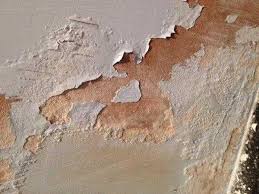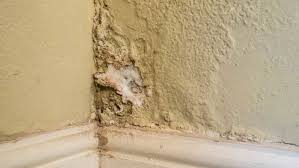

For those old enough to remember, or who have seen the repeats, Rising Damp was a popular sitcom in the mid-1970s. The name was chosen purposely to lend an air of neglect, age and staleness, a theme that ran through the complete series. It kept audiences laughing for many years, and still does today, despite some of the themes that go against modern sensitivities.
However, when it comes to the real-life rising damp, there's nothing to laugh about. Most people believe that damp problems of any kind only affect older, neglected properties, possibly constructed without a damp-proof course. This couldn't be further from the truth, as it is also found in modern buildings for a variety of reasons, including:


When damp proofing fails (or isn't present at all) water can be drawn up through capillary action as the moisture defies gravity through electrical attraction. Don't worry too much about how it all works, it's all to do with physics! The fact is, ground water can, in certain circumstances, rise upwards through porous building materials such as concrete floors or brick/masonry walls and, if not discovered and treated in time, can cause structural damage as well as spoiling paint, wallpaper, carpets, floorings, floor boards, skirting boards, and so on.
Arguments on this very subject have raged for several years, with some sources claiming that this age-old problem is a myth. Anyone who has had to deal with this in their home or business will know otherwise! The fact is, much of the confusion comes down to a lack of experience in identifying which type of damp problem you are dealing with. Unfortunately, there is sometimes also an element of dishonesty, as unscrupulous businesses may claim that a property is suffering from this condition so that they can gain from providing unnecessary treatments.
In either case, the treatment often fails and the problem remains.
What can be said with certainty is that rising damp is not as common as other types of damp, such as that which is caused by condensation.
But just because rising damp is rare, does not mean that it is not real! And one of the biggest factors is location.
An experienced and competent expert will understand that most building materials contain moisture to some extent. Our ancestors understood this when building castles or manor houses with moats, or even everyday homes. They allowed for the fact that the bottom layers of brickwork or masonry forming the external walls would be in constant contact with the ground, and that it would sometimes be damp.
To stop water from rising, they sometimes inserted a physical barrier in the walls of buildings, usually a layer of slate, which has been replaced in more recent times with damp-proof membranes or even a water repellent chemical.
The moisture levels within the walls will rise and fall naturally, with most of it evaporating before it rises far enough to cause any damage to internal walls, plaster, fixtures and fittings.
The problem usually arises in properties situated within valleys, on impermeable soils, or in a place where the soil is constantly wet for whatever reason. These properties will be sitting in continuously damp ground, which can accumulate at the base of walls and become excessively damp. Under these conditions, the moisture can travel upwards, especially in cases where successive layers of render have been used, externally or internally.












You might notice damp patches (or 'tide marks') or even white salt deposits on walls. Stains will appear up to a metre high on internal walls but rarely go beyond this point. The trouble is, contamination from soluble salts in the ground water can cause problems by itself, as some of these may be hygroscopic salts (usually nitrates and chloride) that attract and absorb water, which makes the problem worse.
Even when the rising damp problem has been resolved, salt contamination has to be dealt with separately as it will continue to attract any moisture or humidity in the room.
A musty smell is another sign of damp walls. This tells you that the problem has been there a while as it's had time to soak into the plaster or timber which will begin to rot.
If you spot black mould on any surface (especially on upper levels and around windows) your problem is more likely to be condensation caused by a lack of proper ventilation.
External walls may show signs too, with crumbling mortar and salt stains.
True rising damp will only be found at ground floor level, whereas penetrating damp (or water ingress) can be found several metres up, where water has entered through deteriorating brickwork or masonry walls, or a leaking roof.
Determining whether your problem is caused by rising damp, penetrating damp, or condensation will probably take an expert eye. The correct identification is essential when deciding which of the treatment options to use, and it isn't as simple as inserting or fixing a damp barrier and hoping for the best!
Official diagnosis should be carried out by our qualified damp surveyor or rising damp treatment specialist in Washington. Before any treatment takes place, the examination will entail stripping back any wallpaper and salt-contaminated plaster (at least 300mm above the 'tide mark') to reveal the brickwork beneath which will allow them to assess the extent of the problem.
After checking the existing DPC for breaches (usually in buildings constructed after 1875 as many older buildings did not have damp proof courses) the contractor will decide whether this can be fixed or will need to be replaced. These days a chemical injection DPC is often used to provide protection from further water damage.
Once the new DPC is installed then you are advised to wait for at least 6 months (sometimes up to a year) for the walls to dry out completely before redecorating.
Although products are available for you to tackle this problem yourself, identification and treatment is always best left to the experts, many of whom will offer a redecoration and repair service.

